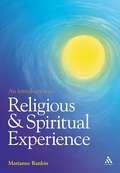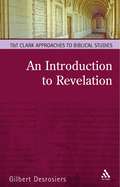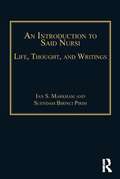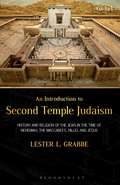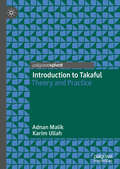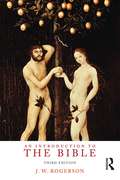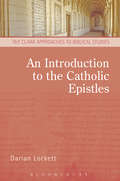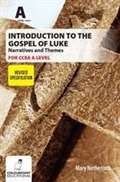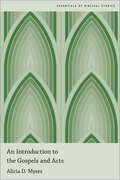- Table View
- List View
An Introduction to Religious and Spiritual Experience
by Marianne RankinThis comprehensive new introduction looks at spiritual experiences from past to present, from the experiences of the founders of the major world religious traditions to events in the lives of ordinary people today. Mystical and Near Death Experiences are included. Examples are drawn from a variety of sources, including original accounts from the Alister Hardy Religious Experience Research Centre Archive at the University of Wales, Lampeter as well as many given to the author in person. Interpretations of these experiences follow, from religious, philosophical and scientific viewpoints. Various questions are considered. Is there a common core to spiritual experience? Do these experiences offer proof of the existence of God or of the possibility of survival of death? This fascinating work concludes with an evaluation of what can be learned about consciousness, religion and what it is to be human.
An Introduction to Religious Language: Exploring Theolinguistics in Contemporary Contexts
by Valerie HobbsReligious language is all around us, embedded in advertising, politics and news media. This book introduces readers to the field of theolinguistics, the study of religious language. Investigating the ways in which people talk to and about God, about the sacred and about religion itself, it considers why people make certain linguistic choices and what they accomplish.Introducing the key methods required for examining religious language, Valerie Hobbs acquaints readers with the most common and important theolinguistic features and their functions. Using critical corpus-assisted discourse analysis with a focus on archaic and other lexical features, metaphor, agency and intertextuality, she examines religious language in context. Highlighting its use in both expected locations, such as modern-day prayer and politics, and unexpected locations including advertising, sport, healthcare and news media, Hobbs analyses the shifting and porous linguistic boundaries between the religious and the secular. With discussion questions and lists of further readings for each chapter, and a companion website featuring video excerpts, tools for corpus research and links to archives, this is the ideal introduction to the study of religious language.
An Introduction to Revelation: A Pathway to Interpretation (T&T Clark Approaches to Biblical Studies)
by Gilbert DesrosiersThe interpretation of the book of Revelation has always aroused controversy, and its use (and abuse) during periods of rapid change has often been a cause for great concern. This volume is intended for students of biblical studies, attempts a responsible reading of Revelation Desrosiers presents the reader with both the tools and the information required to understand the many approaches that may be taken to interpreting the book, and leads the reader toward a sound interpretation.
An Introduction to Said Nursi: Life, Thought, and Writings
by Ian S. Markham Suendam Birinci PirimContemporary Islamic thinkers are often studied sociologically rather than as theologians. There are many accessible introductions to Christian theologians, but very few such studies of Islamic thinkers. This book, and this series, seeks to change this situation: offering new introductions to influential Islamic thinkers and engaging, at the level of ideas, with the rich depths of contemporary Islamic theology. This book introduces to the English-speaking world the leading modern Islamic thinker Said Nursi (1878-1960) - who has some nine million followers in modern day Turkey and around the world. After an opening chapter that provides an overview of his life, the next four chapters outline the theology of Nursi on God, the Qur'an, the West and Politics. The final section provides an invaluable resource of readings from Nursi's most important writings. Providing an introduction to a major form of Islam which is committed to non-violence, dialogue and constructive relationships with the West, this is the first student textbook to introduce a contemporary Islamic theologian in a systematic way.
An Introduction to Said Nursi: Life, Thought, and Writings
by Ian S. Markham Suendam Birinci PirimContemporary Islamic thinkers are often studied sociologically rather than as theologians. There are many accessible introductions to Christian theologians, but very few such studies of Islamic thinkers. This book, and this series, seeks to change this situation: offering new introductions to influential Islamic thinkers and engaging, at the level of ideas, with the rich depths of contemporary Islamic theology. This book introduces to the English-speaking world the leading modern Islamic thinker Said Nursi (1878-1960) - who has some nine million followers in modern day Turkey and around the world. After an opening chapter that provides an overview of his life, the next four chapters outline the theology of Nursi on God, the Qur'an, the West and Politics. The final section provides an invaluable resource of readings from Nursi's most important writings. Providing an introduction to a major form of Islam which is committed to non-violence, dialogue and constructive relationships with the West, this is the first student textbook to introduce a contemporary Islamic theologian in a systematic way.
An Introduction to Second Temple Judaism: History and Religion of the Jews in the Time of Nehemiah, the Maccabees, Hillel, and Jesus
by Lester L. GrabbeAn internationally respected expert on the Second Temple period provides a fully up-to-date introduction to this crucial area of Biblical Studies. This introduction, by a world leader in the field, provides the perfect guide to the Second Temple Period, its history, literature, and religious setting. Lester Grabbe magisterially guides the reader through the period providing a careful overview of the most studied sources, the history surrounding them and the various currents within Judaism at the time. This book will be a core text for courses on the Apocrypha and Pseudepigrapha, as well as Qumran, Intertestamental Literature and Early Judaism.
An Introduction to Second Temple Judaism: History and Religion of the Jews in the Time of Nehemiah, the Maccabees, Hillel, and Jesus
by Lester L. GrabbeAn internationally respected expert on the Second Temple period provides a fully up-to-date introduction to this crucial area of Biblical Studies. This introduction, by a world leader in the field, provides the perfect guide to the Second Temple Period, its history, literature, and religious setting. Lester Grabbe magisterially guides the reader through the period providing a careful overview of the most studied sources, the history surrounding them and the various currents within Judaism at the time. This book will be a core text for courses on the Apocrypha and Pseudepigrapha, as well as Qumran, Intertestamental Literature and Early Judaism.
An Introduction To Shamanism (Introduction To Religion Ser.)
by Thomas A. DuBoisShamans are an integral part of communal religious traditions, professionals who make use of personal supernatural experiences, especially trance, as a resource for the wider community's physical and spiritual well-being. This Introduction surveys research on the topic of shamanism around the world, detailing the archaeology and earliest development of shamanic traditions as well as their scientific 'discovery' in the context of eighteenth and nineteenth century colonization in Siberia, the Americas, and Asia. It explores the beliefs and rituals typical of shamanic traditions, as well as the roles of shamans within their communities. It also surveys the variety of techniques used by shamans cross-culturally, including music, entheogens, material culture and verbal performance. The final chapters examine attempts to suppress or eradicate shamanic traditions, the revitalization of shamanism in postcolonial situations, and the development of new forms of shamanism within new cultural and social contexts.
Introduction to Takaful: Theory and Practice
by Adnan Malik Karim UllahThis book provides a comprehensive account of the theory and practice of takaful, which is an Islamic alternative to insurance. The concepts are explained using real-life case studies, calculations, and exhibits to aid in reader learning and reflection. Takaful, both as an academic subject and as well as practice, is growing particularly in the world leading financial and learning hubs such as in the UK and the USA and countries with large Muslim populations in Asia, Africa, and Middle East.
Introduction to the Apocrypha: Jewish Books in Christian Bibles
by Lawrence M. WillsAn ambitious introduction to the Apocrypha that encourages readers to reimagine what “canon” really means Challenging the way Christian and non-Christian readers think about the Apocrypha, this is an ambitious introduction to the deuterocanonical texts of the Christian Old Testaments. Lawrence Wills introduces these texts in their original Jewish environment while addressing the very different roles they had in various Christian canons. Though often relegated to a lesser role, a sort of “Bible-Lite,” these texts deserve renewed attention, and this book shows how they hold more interest for both ancient and contemporary communities than previously thought.
An Introduction to the Bible
by J. W. RogersonA casual reader enters a bookshop looking for a Bible. However, not all the Bibles on display have the same contents! Some have more books than others, some are study editions, some use gender-free language. How did this come about? This Introduction works back through the processes by which the Bible was written, transmitted, copied and declared to be authoritative by various churches. The following topics are dealt with: What is the Bible?; How Biblical Writers Wrote; The Making of the Old Testament; The Making of the Apocrypha; The Making of the New Testament; The Canon of the Bible; The Study of the Bible; The Use of the Bible in Social, Moral and Political Questions. This updated edition takes account of developments in scholarship since the book was first published in 1999 by Penguin. The original edition has been translated into Spanish and Portuguese.
An Introduction to the Bible
by J. W. RogersonA casual reader enters a bookshop looking for a Bible. However, not all the Bibles on display have the same contents! Some have more books than others, some are study editions, some use gender-free language. How did this come about? This Introduction works back through the processes by which the Bible was written, transmitted, copied and declared to be authoritative by various churches. The following topics are dealt with: What is the Bible?; How Biblical Writers Wrote; The Making of the Old Testament; The Making of the Apocrypha; The Making of the New Testament; The Canon of the Bible; The Study of the Bible; The Use of the Bible in Social, Moral and Political Questions. This updated edition takes account of developments in scholarship since the book was first published in 1999 by Penguin. The original edition has been translated into Spanish and Portuguese.
An Introduction to the Catholic Epistles (T&T Clark Approaches to Biblical Studies)
by Darian LockettThis book introduces the Epistles and discusses the different interpretive approaches which have been used to gain a clearer understanding of them. An introductory chapter defines the Epistles and describes the history of their canonization, following chapters are devoted to each of the texts with each chapter including: 1) historical-cultural background; 2) the social-scientific context; 3) social-rhetorical purposes; 4) narrative discourse; 5) postcolonial and 6) feminist insights; and finally 7) theological perspectives. At the end of each chapter there are suggestions for further reading and a list of reflection questions. Several chapters include a section or two considering a particular interpretive issue especially relevant to the particular text. After taking up each text, Lockett considers again whether the Epistles are a unified whole or to be heard as individual voices. Here the book interacts with some of the ideas of Rob Wall and David Nienhuis regarding the various thematic/theological connections running through the texts. A final chapter takes up the relationship between the Pauline Epistles and the Catholic Epistles within the New Testament.
An Introduction to the Catholic Epistles (T&T Clark Approaches to Biblical Studies)
by Darian LockettThis book introduces the Epistles and discusses the different interpretive approaches which have been used to gain a clearer understanding of them. An introductory chapter defines the Epistles and describes the history of their canonization, following chapters are devoted to each of the texts with each chapter including: 1) historical-cultural background; 2) the social-scientific context; 3) social-rhetorical purposes; 4) narrative discourse; 5) postcolonial and 6) feminist insights; and finally 7) theological perspectives. At the end of each chapter there are suggestions for further reading and a list of reflection questions. Several chapters include a section or two considering a particular interpretive issue especially relevant to the particular text. After taking up each text, Lockett considers again whether the Epistles are a unified whole or to be heard as individual voices. Here the book interacts with some of the ideas of Rob Wall and David Nienhuis regarding the various thematic/theological connections running through the texts. A final chapter takes up the relationship between the Pauline Epistles and the Catholic Epistles within the New Testament.
An Introduction to the Cognitive Science of Religion: Connecting Evolution, Brain, Cognition and Culture
by Claire WhiteIn recent decades, a new scientific approach to understand, explain, and predict many features of religion has emerged. The cognitive science of religion (CSR) has amassed research on the forces that shape the tendency for humans to be religious and on what forms belief takes. It suggests that religion, like language or music, naturally emerges in humans with tractable similarities. This new approach has profound implications for how we understand religion, including why it appears so easily, and why people are willing to fight—and die—for it. Yet it is not without its critics, and some fear that scholars are explaining the ineffable mystery of religion away, or showing that religion is natural proves or disproves the existence of God. An Introduction to the Cognitive Science of Religion offers students and general readers an accessible introduction to the approach, providing an overview of key findings and the debates that shape it. The volume includes a glossary of key terms, and each chapter includes suggestions for further thought and further reading as well as chapter summaries highlighting key points. This book is an indispensable resource for introductory courses on religion and a much-needed option for advanced courses.
An Introduction to the Cognitive Science of Religion: Connecting Evolution, Brain, Cognition and Culture
by Claire WhiteIn recent decades, a new scientific approach to understand, explain, and predict many features of religion has emerged. The cognitive science of religion (CSR) has amassed research on the forces that shape the tendency for humans to be religious and on what forms belief takes. It suggests that religion, like language or music, naturally emerges in humans with tractable similarities. This new approach has profound implications for how we understand religion, including why it appears so easily, and why people are willing to fight—and die—for it. Yet it is not without its critics, and some fear that scholars are explaining the ineffable mystery of religion away, or showing that religion is natural proves or disproves the existence of God. An Introduction to the Cognitive Science of Religion offers students and general readers an accessible introduction to the approach, providing an overview of key findings and the debates that shape it. The volume includes a glossary of key terms, and each chapter includes suggestions for further thought and further reading as well as chapter summaries highlighting key points. This book is an indispensable resource for introductory courses on religion and a much-needed option for advanced courses.
Introduction to the Devout Life
by Allan Ross St. Francis de SalesThis masterpiece of Christian literature by a 16th-century priest explains how to live a holy life in the secular world. Drawn from the letters of St. Francis de Sales, it presents clear and direct advice about praying, resisting temptation, and maintaining devotion to God. A key figure in France's Counter Reformation, St. Francis de Sales (1567-1622) served as Bishop of Geneva and was canonized in 1665. The popularity of his prolific writings on spirituality led to his nomination as the patron saint of authors and journalists. Today's readers feel a special affinity for St. Francis, whose suggestions for living a truly Christian life don't involve withdrawal from the world. In this enduring spiritual guide, his remarkably modern advice appears in the form of letters. The saint's frank and practical counsel ranges from embracing meditations that strengthen the resolve to maintain a virtuous existence to performing daily exercises that renew the soul.
An Introduction To The Gospel Of Luke And Themes In The Synoptic Gospels For CCEA A Level
by Mary NethercottEntirely new book for the revised Religious Studies specification covering AS1: An Introduction to the Gospel of Luke and A21: Themes in the Synoptic Gospels. A detailed and well-researched study that also covers other aspects of the human experience. Tasks provided throughout.
An Introduction to the Gospels and Acts (Essentials of Biblical Studies)
by Alicia D. MyersIntroducing the Gospels and Acts is not just about reading the first five books of the New Testament. It requires entering the first century Mediterranean world where the events in these writings happened. In this short book, Alicia D. Myers takes readers on a journey through the Gospels and Acts, introducing them to the world of Jesus of Nazareth and of the believers who composed and shared stories inspired by him. Myers provides overviews of context and major passages in each canonical work, and also introduces readers to the Apocryphal Gospels and Acts to demonstrate the larger phenomenon of early Christian writing. After situating readers in the literary context of the Gospels and Acts, Myers focuses on the writings themselves, giving basic historical background before digging more deeply into a chosen contextual theme for each work. These six themes include the politics and history of Roman Palestine, expressions of Second Temple Judaism, understandings of identity and human worth in the Roman world, hospitality, Hellenistic philosophies, and the process of canonizing the New Testament. Rather than shying away from difficult and often confusing elements of the Gospels and Acts, Myers invites readers to engage more deeply and situate themselves more fully in the strangeness and surprising familiarity of the Roman world. In this way, readers will see the continuing relevance of the Gospels and Acts for today and learn to be responsible readers of these works for years to come.
An Introduction to the Gospels and Acts (Essentials of Biblical Studies)
by Alicia D. MyersIntroducing the Gospels and Acts is not just about reading the first five books of the New Testament. It requires entering the first century Mediterranean world where the events in these writings happened. In this short book, Alicia D. Myers takes readers on a journey through the Gospels and Acts, introducing them to the world of Jesus of Nazareth and of the believers who composed and shared stories inspired by him. Myers provides overviews of context and major passages in each canonical work, and also introduces readers to the Apocryphal Gospels and Acts to demonstrate the larger phenomenon of early Christian writing. After situating readers in the literary context of the Gospels and Acts, Myers focuses on the writings themselves, giving basic historical background before digging more deeply into a chosen contextual theme for each work. These six themes include the politics and history of Roman Palestine, expressions of Second Temple Judaism, understandings of identity and human worth in the Roman world, hospitality, Hellenistic philosophies, and the process of canonizing the New Testament. Rather than shying away from difficult and often confusing elements of the Gospels and Acts, Myers invites readers to engage more deeply and situate themselves more fully in the strangeness and surprising familiarity of the Roman world. In this way, readers will see the continuing relevance of the Gospels and Acts for today and learn to be responsible readers of these works for years to come.
Introduction to the History of Indian Buddhism (Buddhism and Modernity)
by Eugène BurnoufThe most influential work on Buddhism to be published in the nineteenth century, Introduction à l’histoire du Buddhisme indien, by the great French scholar of Sanskrit Eugène Burnouf, set the course for the academic study of Buddhism—and Indian Buddhism in particular—for the next hundred years. First published in 1844, the masterwork was read by some of the most important thinkers of the time, including Schopenhauer and Nietzsche in Germany and Emerson and Thoreau in America. Katia Buffetrille and Donald S. Lopez Jr.’s expert English translation, Introduction to the History of Indian Buddhism, provides a clear view of how the religion was understood in the early decades of the nineteenth century. Burnouf was an impeccable scholar, and his vision, especially of the Buddha, continues to profoundly shape our modern understanding of Buddhism. In reintroducing Burnouf to a new generation of Buddhologists, Buffetrille and Lopez have revived a seminal text in the history of Orientalism.
Introduction to the History of Indian Buddhism (Buddhism and Modernity)
by Eugène BurnoufThe most influential work on Buddhism to be published in the nineteenth century, Introduction à l’histoire du Buddhisme indien, by the great French scholar of Sanskrit Eugène Burnouf, set the course for the academic study of Buddhism—and Indian Buddhism in particular—for the next hundred years. First published in 1844, the masterwork was read by some of the most important thinkers of the time, including Schopenhauer and Nietzsche in Germany and Emerson and Thoreau in America. Katia Buffetrille and Donald S. Lopez Jr.’s expert English translation, Introduction to the History of Indian Buddhism, provides a clear view of how the religion was understood in the early decades of the nineteenth century. Burnouf was an impeccable scholar, and his vision, especially of the Buddha, continues to profoundly shape our modern understanding of Buddhism. In reintroducing Burnouf to a new generation of Buddhologists, Buffetrille and Lopez have revived a seminal text in the history of Orientalism.
Introduction to the History of Indian Buddhism (Buddhism and Modernity)
by Eugène BurnoufThe most influential work on Buddhism to be published in the nineteenth century, Introduction à l’histoire du Buddhisme indien, by the great French scholar of Sanskrit Eugène Burnouf, set the course for the academic study of Buddhism—and Indian Buddhism in particular—for the next hundred years. First published in 1844, the masterwork was read by some of the most important thinkers of the time, including Schopenhauer and Nietzsche in Germany and Emerson and Thoreau in America. Katia Buffetrille and Donald S. Lopez Jr.’s expert English translation, Introduction to the History of Indian Buddhism, provides a clear view of how the religion was understood in the early decades of the nineteenth century. Burnouf was an impeccable scholar, and his vision, especially of the Buddha, continues to profoundly shape our modern understanding of Buddhism. In reintroducing Burnouf to a new generation of Buddhologists, Buffetrille and Lopez have revived a seminal text in the history of Orientalism.
An Introduction to the Johannine Gospel and Letters (T&T Clark Approaches to Biblical Studies)
by Jan van der WattThis accessible guide to the Gospel and Letters of John introduces readers to key issues arising from historical, literary, and theological approaches to the Johannine literature, also discussing the methodological rationale underlying each of these approaches. After introducing the reader to the development of the narrative structure of the book, the message (theology) is discussed in detail, with the aim of introducing the reader to the interrelatedness of the multiple theological ideas in this Gospel. Similarities, but also differences between the Gospel and Letters are constantly considered. Familiar with the content of the Gospel, readers are then confronted with questions about the origin, development and socio-cultural nature of the Gospel and letters. In each case the scholarly field is briefly reviewed and major solutions are discussed. Thorough discussions on different issues are presented in different chapters, each time referring to the relevant methodological approaches. How do the Gospel and Letters relate to the synoptics, or the Old Testament? Do we have a Gospel composed of multiple sources or is it a seamless document. How was this influential document written and where do the ideas found in the Gospel come from? Since the aim of this book is to form a solid and comprehensive basis for future study of the Johannine literature, readers are placed firmly within the scholarly currents and streams of the Johannine literature. In terms of a metaphor: after reading the book, explorers will know what is out there and why. Now they can start to dig deeper for themselves without feeling lost in an uncharted land.
An Introduction to the New Testament: The Abridged Edition (The Anchor Yale Bible Reference Library)
by Raymond E. Brown Marion SoardsSince its publication in 1997, Raymond Brown’s Introduction to the New Testament has been widely embraced by modern readers seeking to understand the Christian Bible. Acknowledged as a paragon of New Testament studies in his lifetime, Brown was a gifted communicator who wrote with ease and clarity. Abridged by Marion Soards, who worked with Brown on the original text, this new, concise version maintains the essence and centrist interpretation of the original without tampering with Brown’s perspective, insights, or conclusions. The biblical writings themselves remain the focus, but there are also chapters dealing with the nature, origin, and interpretation of the New Testament texts, as well as chapters concerning the political, social, religious, and philosophical world of antiquity. Furthermore, augmenting Brown’s commentary on the New Testament itself are topics such as the Gospels’ relationship to one another; the form and function of ancient letters; Paul’s thought and life, along with his motivation, legacy, and theology; a reflection on the historical Jesus; and a survey of relevant Jewish and Christian writings. This comprehensive, reliable, and authoritative guidebook is now more accessible for novices, general readers, Bible study groups, ministers, scholars, and students alike.
